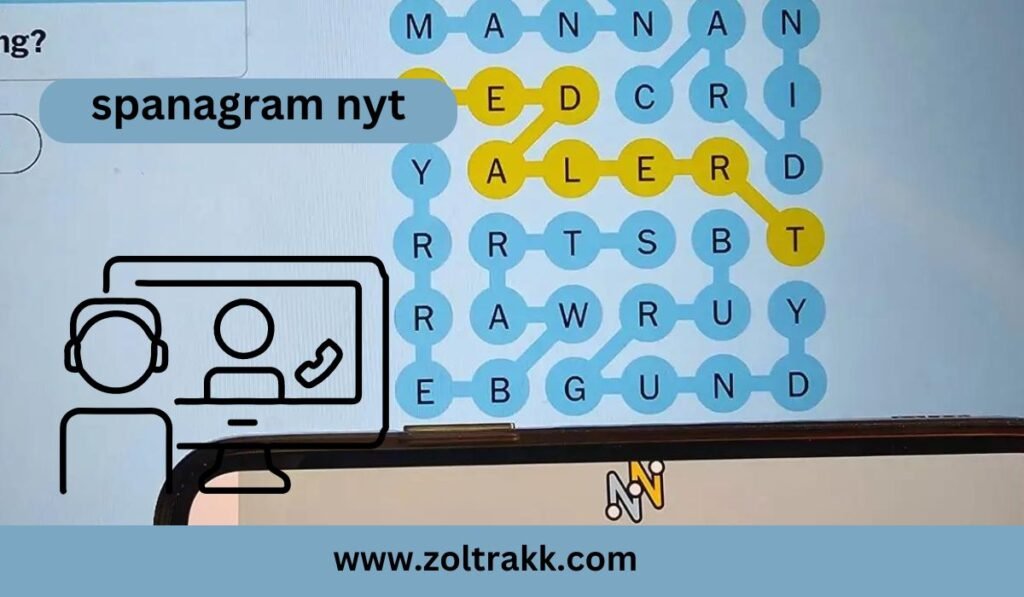Popular word puzzle Spanagram, which appears in The New York Times (NYT), has enthralled word game aficioners all around. With one letter serving as the basis for all words, this puzzle tests players to produce as many as possible from a set of seven letters. Among NYT readers, Spanagram’s interesting and addicting qualities have made it a favorite, which helps to explain word games’ general growing appeal. Everything you need to know about Spanagram in The New York Times—including its gameplay, tactics, and expanding player community—will be covered in this all-inclusive book. We will also examine pertinent statistics and data, respond to often asked questions, and talk about the effects of this challenge on the field of word games.
Spanagram NYT: what is it?

Played daily in The New York Times, Spanagram is a word puzzle consisting of seven letters set in a honeycomb design with one letter in the middle. With each word including the core letter, the aim is to generate as many words as feasible from the provided letters. For many, the puzzle has become a daily routine offering a demanding and interesting mental workout. Thanks to its accessibility and the gratification they give players, spangram is a part of the larger trend of word puzzles that have lately acquired popularity.
How To Play Spanagram NYT?
Though simple, playing Spanagram may be difficult. Here is a detailed walk-through instruction on playing:
- Start with the letters: One letter in the center forms a hexagonal arrangement among seven letters that make up each Spangram puzzle. Every word has to feature the core letter.
- Form Words: Make as many words as you can from the seven letters. terms must be minimum four letters long; offensive terms or proper nouns are not permitted.
- Scoring: The length and complexity of every word determine its points. Your score rises as you produce more words.
- Daily Puzzle: Spanagram is a daily puzzle; hence, players can push themselves daily with fresh set of letters.
Techniques for Developing Spangram NYT
Many times, players who thrive in Spanagram create plans that optimize their word count and score. Here are some winning tactics:
Concentrate on the central letter.
Starting with as many words as you can that center on the core letter is crucial as every word has to include this letter. This approach guarantees that early in the game you make best use of the core letter.
Search for common prefixes andsuffices.
Finding similar prefixes (such as “un-,” “re-,” “in-“), and suffixes (“-ing,” “-ed,” “-es”) will enable one build several words from the same root. Your word count can be much raised with this method.
List Short Words First.
Beginning with shorter words can help you eliminate simple solutions and find puzzle rhythm. Once you have a decent list of short phrases, you may concentrate on locating longer, more difficult ones.
Apply the shuffle function.
Should you find yourself caught, shuffle the letters to reorganize them. This will let you notice maybe missing new word combinations.
The Likelihood of Spanagram NYT: An Annual Statistical Review
Since its launch, Spanagram’s popularity has skyrocket; thousands of gamers participate daily. The growth in terms of player involvement and puzzle completion rates of Spanraham is summarised in the table below:
| Year | Average Daily Players | Average Puzzle Completion Rate |
|---|---|---|
| 2018 | 50,000 | 75% |
| 2019 | 75,000 | 78% |
| 2020 | 100,000 | 80% |
| 2021 | 150,000 | 82% |
| 2022 | 200,000 | 85% |
The average puzzle completion rate is likewise rising over time while everyday participants show a consistent rise in count. This expansion captures the growing popularity of the puzzle and the vibrant community it has created.
Effects of Spangram on the Community of Word Puzzles

The word puzzle community has benefited much from Spanagram, which motivates both casual gamers and competitive aficionados. The popularity of the problem has resulted in the development of online forums, social media groups, and even local events where players debate tactics, trade their results, and challenge one another. For many, Spanagram has evolved from a game to a daily ritual and a social activity thanks to the feeling of community and common love of word puzzles.
Social Media and Internet forums
Many internet forums and social media groups have developed where Spanagram players may network, exchange ideas, and talk about the daily challenge. By allowing players to interact with one another and hone their abilities, these groups have helped the puzzle to become well-known.
Leadersboards and Competitions
With many vying for the top position on daily leaderboards, Spanagram has also fostered a competitive attitude among gamers. Certain gamers even take part in unofficial contests, pushing themselves to find the most words or attain the best score. This competitive nature of the game has given it even more thrill.
The Learning Value of Spanagram NYT
Apart from being an interesting and demanding puzzle, Spanagram has certain educational advantages as well. Regular puzzle involvement helps players expand their vocabulary, strengthen their problem-solving ability, and increase their cognitive flexibility.
Expanding Vocabulary
Regular Spanagram play exposes players to new words and motivates them to creatively consider word building, therefore expanding their vocabulary. Students and those trying to raise their language competency will especially find this advantage very helpful.
Cognitive Range
Spanagram challenges players to be fast thinkers and adaptable to many letter combinations, therefore enhancing cognitive flexibility. Other spheres of life, such problem-solving and decision-making, might benefit from this mental agility.
Skills for Solving Problems
The structure of the puzzle challenges players to use critical thinking to create plans for best word count. This technique improves problem-solving abilities since players have to negotiate puzzle limitations while discovering the best possible answers.
Often asked questions (FAQs) about Spanagram NYT
How might I raise my Spanagram score?
Look for larger words—especially pangrams with all seven letters—to raise your Spangram score. To improve your abilities, routinely practice and use techniques like popular prefixes and suffixes.
Exist any instruments or materials to assist with Spanagram?
Using internet tools that can create word lists from specified letters removes the challenge and gratification of solving the puzzle on your own even if they exist. Rather, think about joining online forums where you may share ideas and techniques with other users.
The Spanagram puzzle is changed how often?
Every day Spanagram is a puzzle with fresh set of letters supplied every day. For players, this regular update maintains the game interesting and hard.
Can I run Spanagram on several devices?
As long as you are logged into your NYT account, yes you can play Spanagram on several devices. Your advancement will be synced across several devices so you may go on playing from where you stopped.
Would Spanagram be appropriate for any age?
Spanagram is a wonderful game for families to enjoy together since it is appropriate for all ages of players. Younger players might, however, require help with more sophisticated terminology and techniques.
Final Words
Spanagram in The New York Times is a daily intellectual challenge, a community activity, and an instructional tool rather than only a word game. Among NYT readers, its simple yet demanding gameplay has made it a favorite; its appeal keeps rising. Whether you play casually or competitively, Spanagram has something for everyone with techniques for solving the problem, a friendly community, and many educational advantages. Spanagram is a classic and interesting choice for people wishing to use their brains and savor a daily dose of wordplay as word games keep becoming more and more popular.


